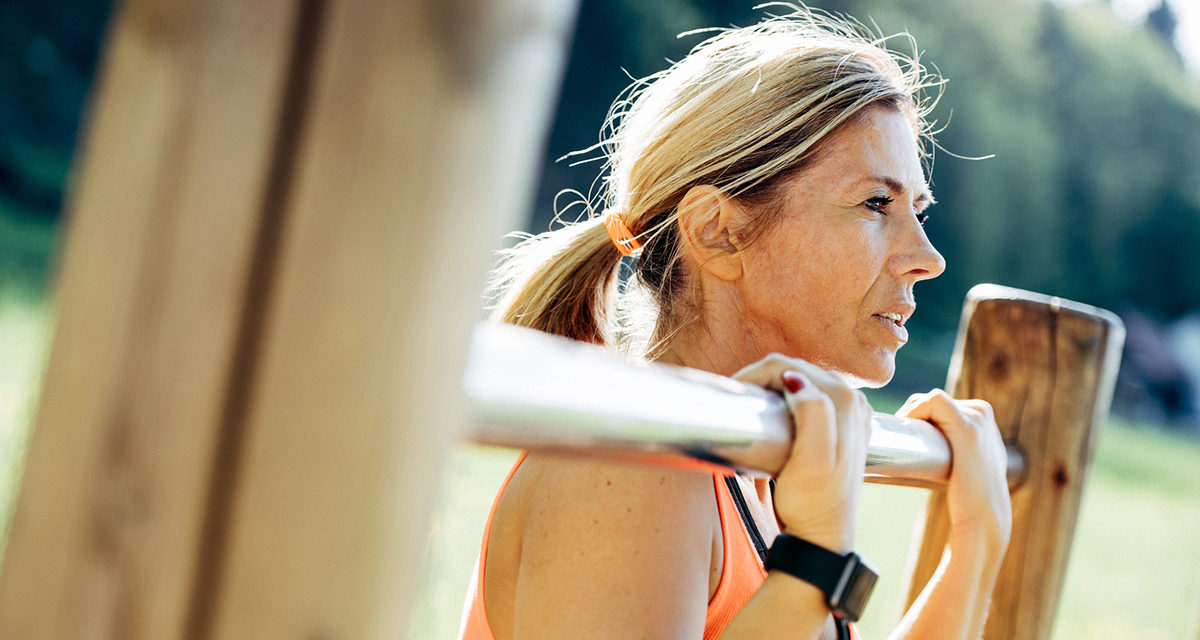Remember the physical fitness test in gym class known as the Presidential Challenge? Girl after girl would line up at the pull-up bar, jump up, and try a pull-up, most of the attempts ending in miserable failure. For women, the pull-up has historically been an unattainable test of strength and fitness, that after years of attempting, most will abandon.
A pull-up might not be on your bucket list, but it was on mine. And at the age of 27, I too almost threw in the towel, but then I decided to give it one last shot. After about 8 weeks of dedicated practice, I was able to get my first pull-up, and then came two and three. Now I am nearing 10. As both a coach and an athlete, I am here to encourage you to keep at it because—like everything else—it just takes practice. Here’s my step-by-step approach to getting that elusive first pull-up. First you need to know the proper technique:
Pull-up: Hanging from a straight bar, face both palms away from you in what is called a double overhand grip. Wrap your thumbs around the bar, the way you would if you were making a fist, to increase your grip strength. Starting from a full hang with feet off the ground, pull yourself up so your chin breaks the plane of the bar, and then lower with control to full hang again.
Chin-up: The movement is the same, but the grip is adjusted so both palms face you. This recruits a bit more of the biceps and tends to be a little easier to perform.
Before you start:
Set your goal: this is the most important part and often the part we skip. Setting realistic and time-bound goals keeps you accountable and gives you a clear target for completion. Make others aware of your goal so they can join you and hold you accountable also! Here’s an example: I will complete 1 strict pull-up by April 3, 2015. Make the goal aggressive yet achievable and ensure there is an end date and a specific and measurable outcome.
Find a bar to practice on. Installing a bar at home would get you to your goal faster because you would be able to practice more frequently, but you could also locate one at your gym for practice. Try and find a straight pull-up bar and not one of the pull-up machines. For a lot of women, I also use the Smith squat machine with the bar adjusted all the way to the highest rack. If a bar is too high, find a step so you don’t have to waste your energy jumping up.
The process:
Hang from the bar. This is as simple as it sounds, hop up to the bar so your feet are off the ground and just hang there. See if you can work towards 30 seconds of hanging for a couple sets to help improve grip strength. Once you can hang from the bar for 30 seconds move to step 2.
Flexed arm hang. Jump yourself up so your chin is over the bar and hold the flexed position for 10 seconds. You can try it with both a chin-up and a pull-up grip. Once you can perform this hang for 10 seconds move to step 3. You can still train this movement even after you’ve moved to the next step. I still incorporate these weekly and am working towards 30 seconds.
Note: Steps 3-6 can be performed in parallel and I will provide an example program below.
Negative pull-ups: Jump yourself up so your chin is over the bar and slowly let yourself down to a full hang. If you’re jumping from a box, you’ll need to bend your legs so you are in a full hang before your feet touch back down. Aim for 5 seconds from chin over the bar to the bottom of the hang. If you fall like a lead weight, then just start with a one-second negative and work the time up over a couple weeks. Perform 4 sets of 4 negative pull-ups. While you’re working on your negative pull-ups, proceed to step 4.
Supine rows/ring rows: Lower the rack on a Smith machine to waist height or a little lower. Alternatively, you could use gymnastics rings or TRX straps set at about the same height. Lay on the floor so you are underneath the bar or rings. Extend your legs out until they are straight and pull yourself up until your chest touches the bar or your thumbs are in your armpits. If this is too difficult, simply bend your legs so your feet are flat on the floor or increase the height of the rings or bar so your body is at more of an angle with the floor rather than parallel. As you improve this movement, you could move the rings lower or elevate your feet to make it harder. Aim for sets of 10-15 on this movement.
Lat pulldown: I like this machine for building some strength, but unfortunately it doesn’t directly carry over to the pull-up. For instance, you could pull your weight down on the machine but still not be able to perform a pull-up. Perform sets of 8-12 with a wide grip for improved strength and muscle mass.
Band-assisted pull-ups: Loop a resistance band around the bar, and secure it under the sole of one foot. Hang from the bar with one foot in the band, and the resistance will assist you in your pull-up. Try and get as many as possible. I prefer this to the pull-up machine because it allows you to hang freely, whereas the machine puts you in an awkward position. Aim for 8-12 repetitions, and as you progress, you may use lighter bands to decrease the amount of assistance.
Note: Once you are proficient at these drills, move to the next one.
Pull-up attempts: Every time you walk past a bar, try a pull-up. Figure out where you’re getting stuck, and focus on holding that position during your negative pull-ups. For example, if you get stuck halfway up, then during your negative pull-ups, hold for as long as possible halfway down on the lowering phase. If you can’t get from the hang to the halfway mark, you need to work on engaging the lats. To do this, pull your shoulder blades back and down, and you should immediately rise an inch or 2 toward the bar. You could also widen your grip—the wider your grip the closer you are to the bar, and every little bit counts. Just keep at it.
Here is a sample program I use with the women I train. If you stay consistent, you will see results.
Tuesday
| Movement | Sets x Reps | Timing/Weight |
| Flexed Arm Hang | 4×4 | 10 seconds |
| Negative Pull-ups | 4×4 | 5 seconds |
| Lat Pulldown | 3×8-12 | Try and start around 75 lbs. and work towards your bodyweight. |
Thursday
| Movement | Sets x Reps | Timing/Weight |
| Band-Assisted Pull-ups | 4 x 8-12 | Lightest band you can use for sets of 12. If you can perform 4 sets of 12, use a lighter band next time. |
| Supine/Ring Rows | 4 x 10-15 | |
| Pull-up Attempts | 5 attempts | Max effort – pull with all your might! |
Saturday
| Movement | Sets x Reps | Timing/Weight |
| Band-Assisted Pull-ups | 10 x 5-8 | Every minute on the minute for 10 minutes. So start at time zero and perform 1 set of 5-8. Then at the start of each minute for 10 minutes perform another set of 5-8. |
Set your goal and get started this week. The ability to perform pull-ups not only builds confidence, but it also builds some nice arm and back muscles in the process (plus it’s just kind of awesome). Let us know how you do!






